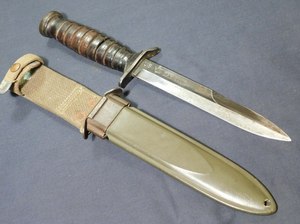
A bayonet is a knife, dagger, sword, or spike-shaped weapon designed to fit on the end of the muzzle of a rifle, carbine, musket or similar firearm, allowing it to be used as a spear-like weapon. The term is traditionally derived from Bayonne, the town in south-west France where bayonets were supposedly first used by Basques in the 17th century. From the early 17th to the early 20th century, it was a melee weapon used by infantry for offensive and/or defensive tactics. Today, it is considered an ancillary weapon or weapon of last resort, although it is still used for ceremonial purposes.

The M1 carbine is a lightweight semi-automatic carbine that was issued to the U.S. military during World War II, the Korean War, and the Vietnam War. The M1 carbine was produced in several variants and was widely used by paramilitary and police forces around the world after World War II.

A trench knife is a combat knife designed to kill or incapacitate an enemy at close quarters, such as in a trench or other confined area. It was developed as a close combat weapon for soldiers attacking enemy trenches during the First World War. An example of a World War I trench knife is the German Army's Nahkampfmesser.

The M9 Bayonet, officially known as the M9 Phrobis III, is a multi-purpose knife and bayonet officially adopted in 1986 by the United States. It has a 7-inch (18 cm) blade and is issued with a sheath designed to double as a wire cutter.

The OKC-3S is a bayonet developed by the United States Marine Corps to replace the M7 bayonet and M9 bayonet as its service bayonet for the M16 family of rifles and M4 series carbine. This multipurpose bayonet provides greater durability than the M7 bayonet and it also functions as a fighting knife.
A combat knife is a fighting knife designed for military use and primarily intended for hand-to-hand or close combat fighting.
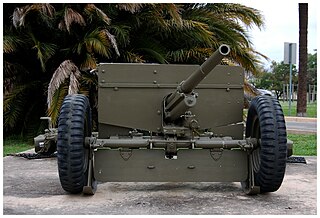
The 37 mm gun M3 is the first dedicated anti-tank gun fielded by United States forces in numbers. Introduced in 1940, it became the standard anti-tank gun of the U.S. infantry with its size enabling it to be pulled by a jeep. However, the continuing improvement of German tanks quickly rendered the 37 mm ineffective and, by 1943, it was being gradually replaced in the European and Mediterranean theaters by the more powerful British-developed 57 mm gun M1. In the Pacific, where the Japanese tank threat was less significant, the M3 remained in service until the end of the war, but some 57mm guns were issued.

The M6 Bayonet is a bayonet used by the U.S. military for the M14 rifle, it can also be used with the Mk 14 Enhanced Battle Rifle as well M39 Enhanced Marksman Rifle. It was introduced in 1957, at the same time as the rifle itself. It is the only bayonet made for the M14.

The M7 bayonet is a bayonet that was used by the U.S. military for the M16 rifle, it can also be used with the M4 carbine as well as many other assault rifles, carbines, and combat shotguns. It can be used as a fighting knife and utility tool. It was introduced in 1964, when the M16 rifle entered service during the Vietnam War.
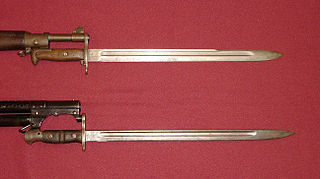
The Model of 1905 bayonet was made for the U.S. M1903 Springfield rifle. This designation was changed to Model 1905 in 1917, and then to M1905 in 1925, when the army adopted the M designation nomenclature. The M1905 bayonet has a 16 in (41 cm) steel blade and a 4 in (10 cm) handle with wooden or plastic grips. The bayonet also fits the U.S. M1 Garand rifle. From 1943 to 1945, a shorter, 10 in (25 cm), bladed version was produced with either black or dark red molded plastic grips, and designated the M1 bayonet. A number of M1905 bayonets were recalled from service, their blades cut down, and reissued as M1 bayonets. But the cut down version was not used in Vietnam.

The 75 mm Howitzer Motor Carriage M8, also known as the M8 Scott, was a self-propelled howitzer vehicle of the United States in use during World War II. It was developed on the chassis of the M5 Stuart tank and was equipped with a M116 howitzer in an M7 mount.
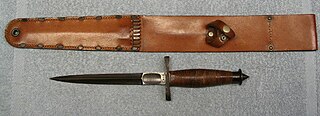
The V-42 stiletto was a fighting knife issued during World War II to the First Special Service Force, a joint American/Canadian commando unit.
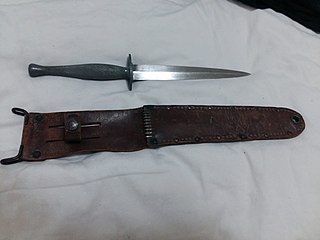
The United States Marine Raider stiletto was issued to the Marine Raiders and 1st Canadian Parachute Battalion during World War II.
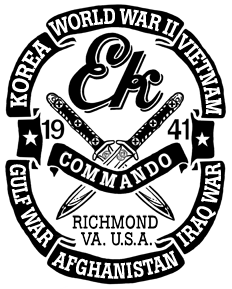
Ek Commando Knife Co. or Ek Knives is an American combat knife brand produced by several different companies since the original founded by John Ek in 1941. In May 2014 the Ek brand was purchased by Ka-Bar, which began selling its versions of Ek knife designs in 2015. Although not officially issued gear, Ek Knives have seen use by US forces in six major conflicts: World War II, the Korean War, the Vietnam War, the Gulf War, both wars in Afghanistan and the Iraq War. Ek Knives manufactures Bowie-style blades, daggers, and a Fairbairn-Sykes MkII. President Franklin Delano Roosevelt, Clark Gable, and General George S. Patton have been identified as Ek knife owners.
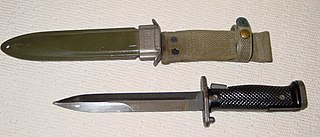
The M5 Bayonet was adopted by the U.S. military in 1953 to replace other bayonets for the M1 Garand rifle. It uses the M8A1 scabbard.
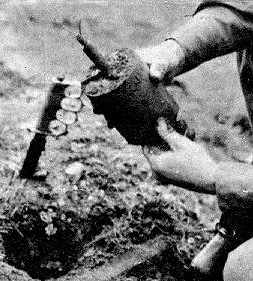
The Mark I trench knife is an American trench knife designed by officers of the American Expeditionary Force (AEF) for use in World War I. It has a 6.75 in (17.1 cm) double-edged dagger blade useful for both thrusting and slashing strokes, unlike previous U.S. trench knives such as the M1917 and M1918. The handle is made of cast bronze and uses a conical steel nut to hold the blade in place. The Mark I's blade was blued with a black oxide finish, the bronze handle was chemically blackened, with cast spikes on the bow of each knuckle. The spikes were intended to prevent an opponent from grabbing the knife hand, as well as to provide a more concentrated striking surface when employed in hand-to-hand combat.
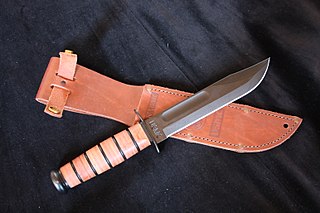
Ka-Bar is the contemporary popular name for the combat knife first adopted by the United States Marine Corps in November 1942 as the 1219C2 combat knife, and subsequently adopted by the United States Navy as the U.S. Navy utility knife, Mark 2. Ka-Bar is the name of a related knife manufacturing company, Ka-Bar Knives., Inc., of Olean, New York, a subsidiary of the Cutco Corporation.

A fighting knife has a blade designed to most effectively inflict injury in close-quarters physical confrontations. The combat knife and the trench knife are examples of military fighting knives.

The M4 bayonet was introduced in 1944 for use with the M1 carbine. It was built on the M3 fighting knife.
